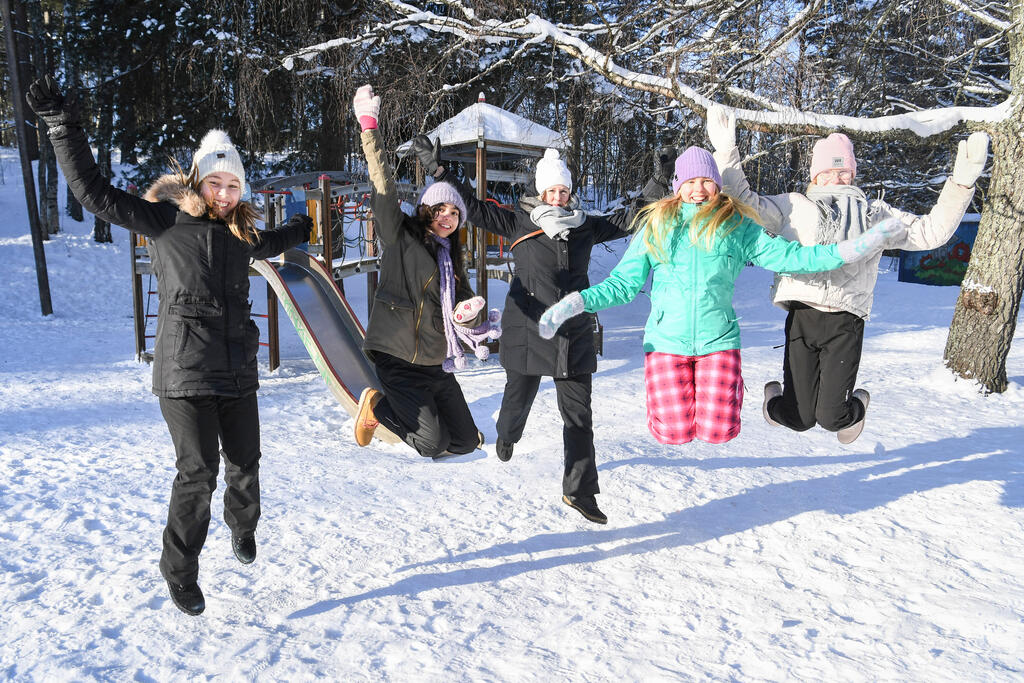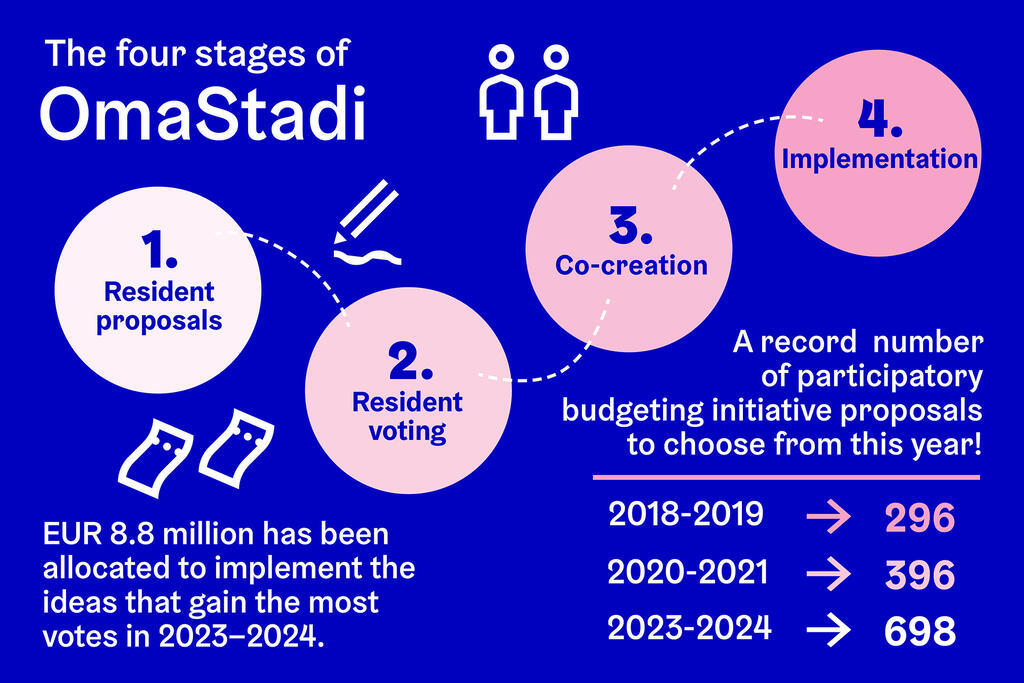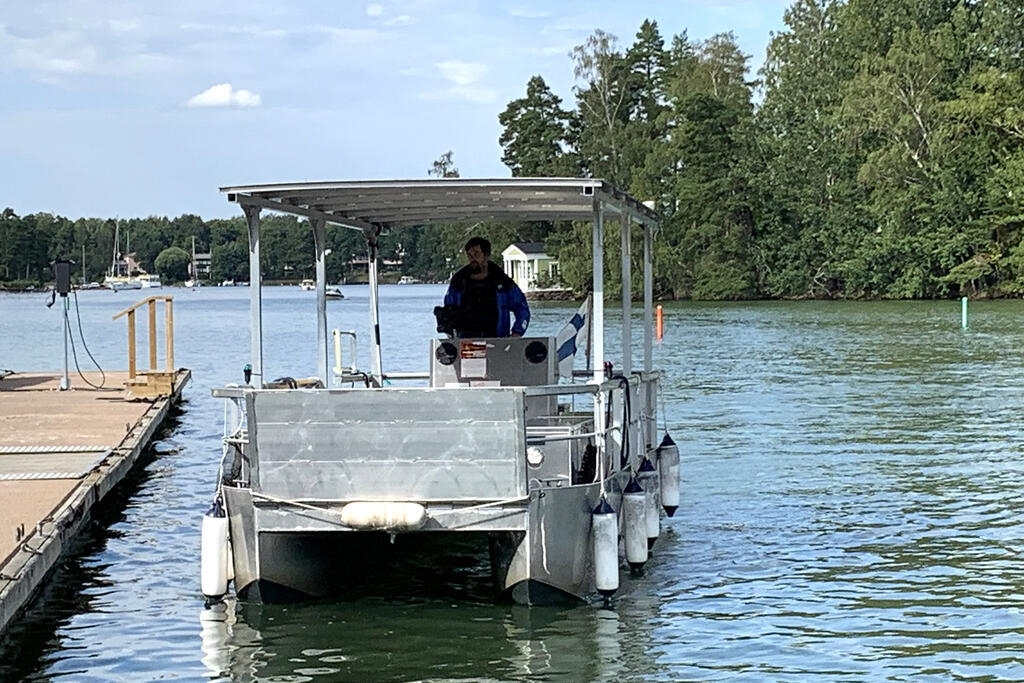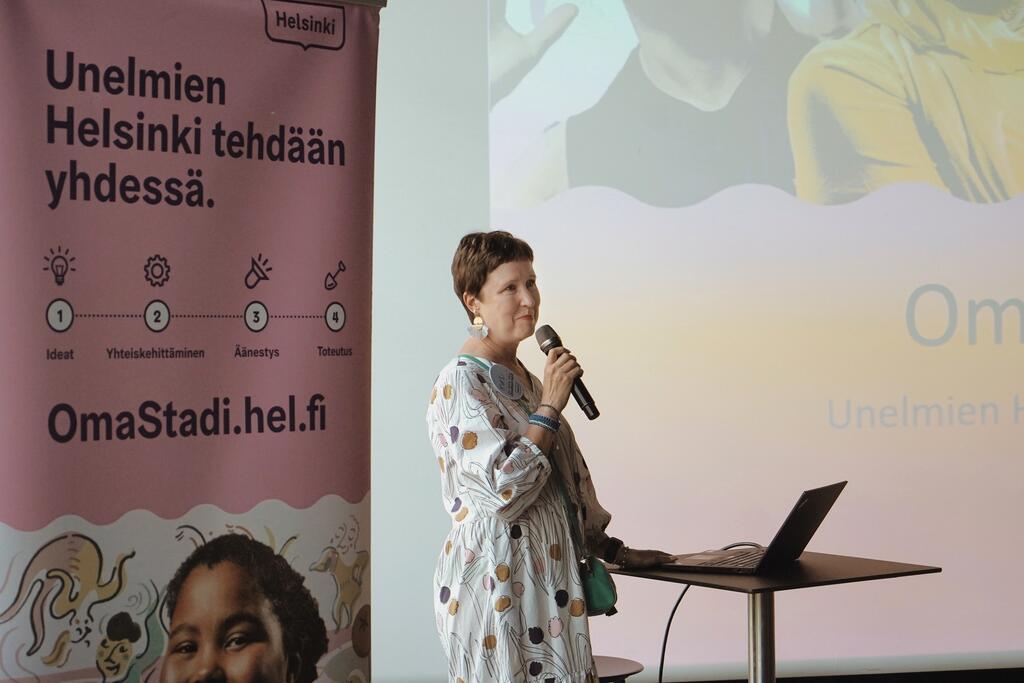
The City of Helsinki’s participatory budgeting initiative known as OmaStadi allows residents of the city to decide on how to use a part of the city’s budget. First, inhabitants are asked to contribute ideas for improving the city and then vote for their favourites. The city then implements those proposals that win the most votes.
The third round of the initiative has close to 700 resident proposals for city dwellers to choose from, and the City of Helsinki has earmarked EUR 8.8 million to turn them into reality.
Proposals that will be open for a vote range from new events and services to construction projects. More than a third of the suggestions are related to exercise and sports, while many others concern to city parks and nature areas. A few are also linked to the built environment.
”The number of community-focused projects rose in particular. For example, many Helsinki residents expressed their desire for more shared public spaces. The themes of wellbeing, ecology and education were also well represented,” said Kirsi Verkka, the city’s Participatory Budgeting Manager.

Record number of proposals submitted
The people of Helsinki submitted more than 1,600 proposals to the third round of the OmaStadi initiative, the highest number of ideas sent to date. Even after the city’s assessment phase, a record number of close to 700 proposals was accepted to go on to the voting stage.
”OmaStadi is in class of its own because the people of Helsinki actively submit proposals and vote. Voting percentages in participatory budgeting initiatives on the international stage are usually limited to one percent or so, but in Helsinki, more than eight percent of the population has always taken part. That’s one of the reasons OmaStadi has attracted interest throughout the world,” said Verkka.
OmaStadi also stands out from many of its peers because Helsinki’s residents have so enthusiastically participated in the co-creation phase that follows the vote. During this phase, residents and experts from the city work as a team to refine the proposals into a feasible project plan.

OmaStadi began in 2016 as a resident idea
OmaStadi is the people of Helsinki’s very own. This is because the idea for the participatory budgeting initiative originated from the city’s residents back in 2016, when Helsinki was looking for new ways to encourage citizen participation. The City of Helsinki wanted the residents' voice to be heard more strongly in budget planning and decision-making, with the goal to strengthen local participation and ascertain the wishes and needs of the people living in the different districts of the city.
The city’s Participation Model and OmaStadi (“MyCity”) were born as a result. In the first round of the initiative, which took place in 2018–2019, EUR 4.4 million was allocated for implementation of the residents’ proposals that won the most votes. In this first round, 1,273 proposals were submitted, 296 proceeded to the voting stage, and 44 in total were implemented. The voting percentage among Helsinki residents in this first round was 8.6.
The second round in 2021–2022 took place over a longer time period, and the allocation from the city budget was doubled to EUR 8.8 million. Residents of the city made 1,463 proposals, of which 396 proceeded to the voting stage, which led to 75 being implemented. The voting percentage in the second round was 8.1.
The ongoing third round has a two-year timetable, and the same EUR 8.8 million has been set aside to make the winning proposals a reality.
To date, 119 OmaStadi resident proposals that gained the most support have been implemented.
“The electric app-activated boat that provided residents with new access to the island of Vartiosaari is a great example of successful project, as are the five new winter swimming spots that have now been established. Several outdoor gyms, playgrounds and barbecue shelters have also been built and many fun events have been organized,” Verkka said.
Some resident proposals can be implemented quite quickly, Verkka said. Ideas that people vote for in the spring can sometimes start to be implemented already the following autumn.
Verkka feels that the OmaStadi initiative has increased people’s understanding of Helsinki’s municipal operations. When the residents work together with the city’s experts to co-create the winning proposals, it becomes clear to them how many things need to be taken into account or how long things like permit processes can take.
In addition, all of the information on the decisions and progress of OmaStadi projects is made publicly available on the omastadi.hel.fi website. The City of Helsinki also benefits from the initiative in many ways, as the OmaStadi proposals, assessment and co-creation work help city employees to learn more about the wishes and needs of many different kinds of residents and associations.

Fine-tuned voting process
The City of Helsinki also consults its residents in the continuous development of the OmaStadi initiative. For example, in the beginning of the programme, the residents and city experts came together to assess and co-create each of the resident proposals as a team, but this was judged to make the process unnecessarily lengthy.
In subsequent rounds, only proposals whose feasibility has been first verified by the city's experts were accepted for consideration. Proposals that are too expensive are now eliminated and similar ideas are often combined.
“Residents don’t necessarily know, for example, who owns the land they are proposing a barbecue shelter for. The city can basically only build on land it owns. The city experts also check to make sure that the proposed changes aren’t already in the works,” Kirsi Verkka said.
The voting process has also been fine-tuned. In the first years of the initiative, voters could choose two kinds of proposals: those that would affect their residential area and others that would affect the whole city. Now, voters must select all five of the proposals they support from a single area of the city known as a major district.
Verkka said it is most common for voters to choose to improve the major district in which they live. Nowadays, the total number of votes is only announced after the end of the three-week voting period, and a running tally is no longer visible on the OmaStadi website.
Information available in seven languages
Helsinki residents have praised the OmaStadi participatory budgeting initiative for increasing the exchange of information and enhancing their sense of community. Participants in the initiative’s workshops reported that work on the proposals allowed them to meet new people and be introduced to different points of view.
”The workshop feedback we received noted that while discussions on social media tends to fall into familiar ruts, when residents sit down face-to-face to discuss issues in their area, the discussion tends to stay constructive. OmaStadi contributes to creating and maintaining a shared understanding of our city. It fosters community spirit, and this is no small thing,” Verkka said.
One of OmaStadi’s goals is to include representatives from as many different groups of residents and associations as possible. That's why information has been made available on different channels in seven languages. There is also no requirement that people be Finish citizens in order to vote, said Titta Reunanen, the City of Helsinki’s Partnership Manager, who also participates in OmaStadi work.
She explained how OmaStadi works closely with many kinds of organisations, so information about the participatory budgeting initiative can spread to as many groups of residents as possible and activate them to help develop the city. Now, if voting activity in one district is lower than in others, the city steps up its cooperation with the local associations in response to this.
More ways to participate and have an influence
Helsinki inhabitants have several other options alongside OmaStadi when it comes to participating in city decision-making and having an influence. Residents are always free to submit a local resident’s initiative, provide feedback on the city's activities and voice their opinion on city planning, as well as attend mayor's resident evenings and vote in municipal elections.
The City of Helsinki also works to connect city workers with the wishes and needs of the capital’s different neighbourhoods. This is partly ensured by the city’s borough liaisons, a team of outreach professionals who were hired to interface with residents in each of the city’s major districts. The liaisons also promote cooperation between local residents and organisations in the area.
All residents over the age of 13 are eligible to vote on OmaStadi proposals, but in addition to this, young people can make a difference at their school, for example, with the help of the Youth Budget, initially known by the name of RuutiBudjetti.
Many schools utilise the OmaStadi participatory budgeting initiative when instructing their students about different kinds of civil engagement and participation. It is an effective way for Helsinki residents to have a wide-ranging influence in the working of their hometown.
OmaStadi voting is open from 28 February to 17 March
The proposals for the third round of the OmaStadi participatory budgeting initiative are available online at omastadi.hel.fi. Residents of the city can cast a total of five votes for their favourite proposals starting on Wednesday, 28 February at 8.00. Voting will close on Sunday, 17 March at 23.00, and the results will be published on the website on Monday, 18 March at noon.
Everyone over the age of 13 who lives in Helsinki can vote for a maximum of five proposals in one major district. The seven major districts of Helsinki function as the voting areas, and they receive funding from OmaStadi in proportion to their population. For this reason, varying amounts of proposals are implemented in different areas. The price of the proposal naturally also has an effect, as it possible to implement a greater number of proposals that can be implemented with a smaller budget.
Helsinki residents must show some form of strong identification, such as online banking codes, to cast their votes in OmaStadi. In order to encourage young people’s participation, students can also use the school's Wilma or edu.hel.fi credentials to vote, if necessary.
There are some 60 service locations in Helsinki that can assist residents to access the website and cast their votes. Examples include local libraries, community houses and the city’s info stands.